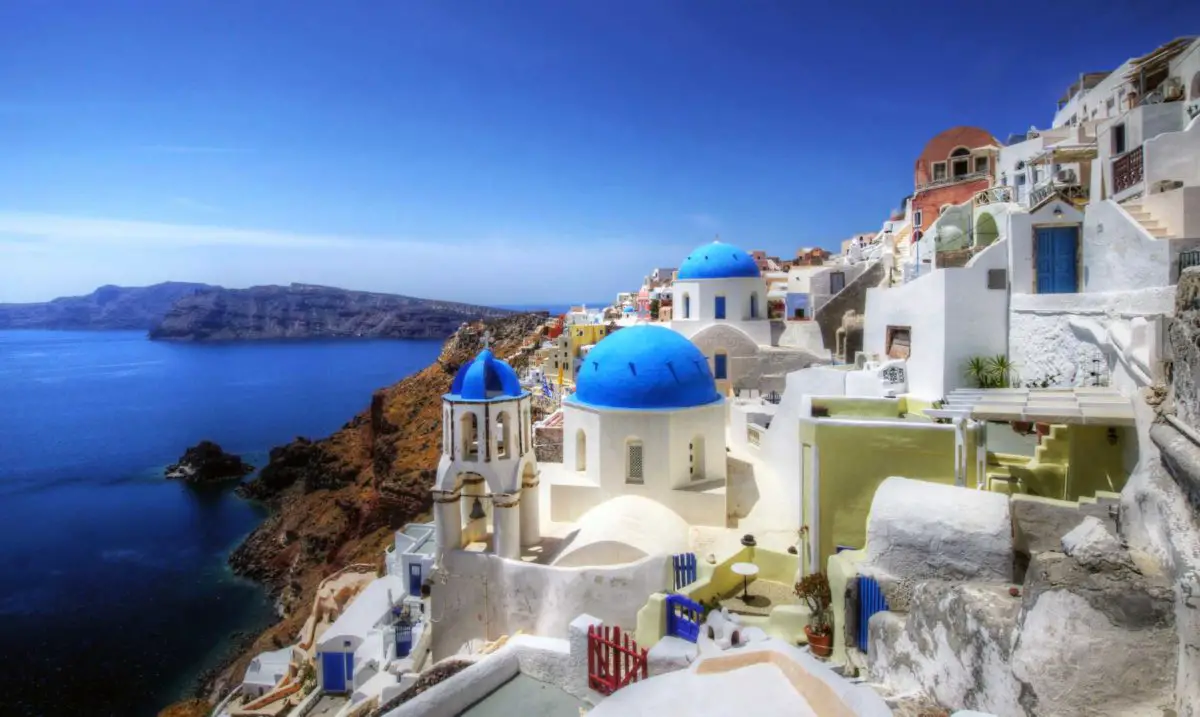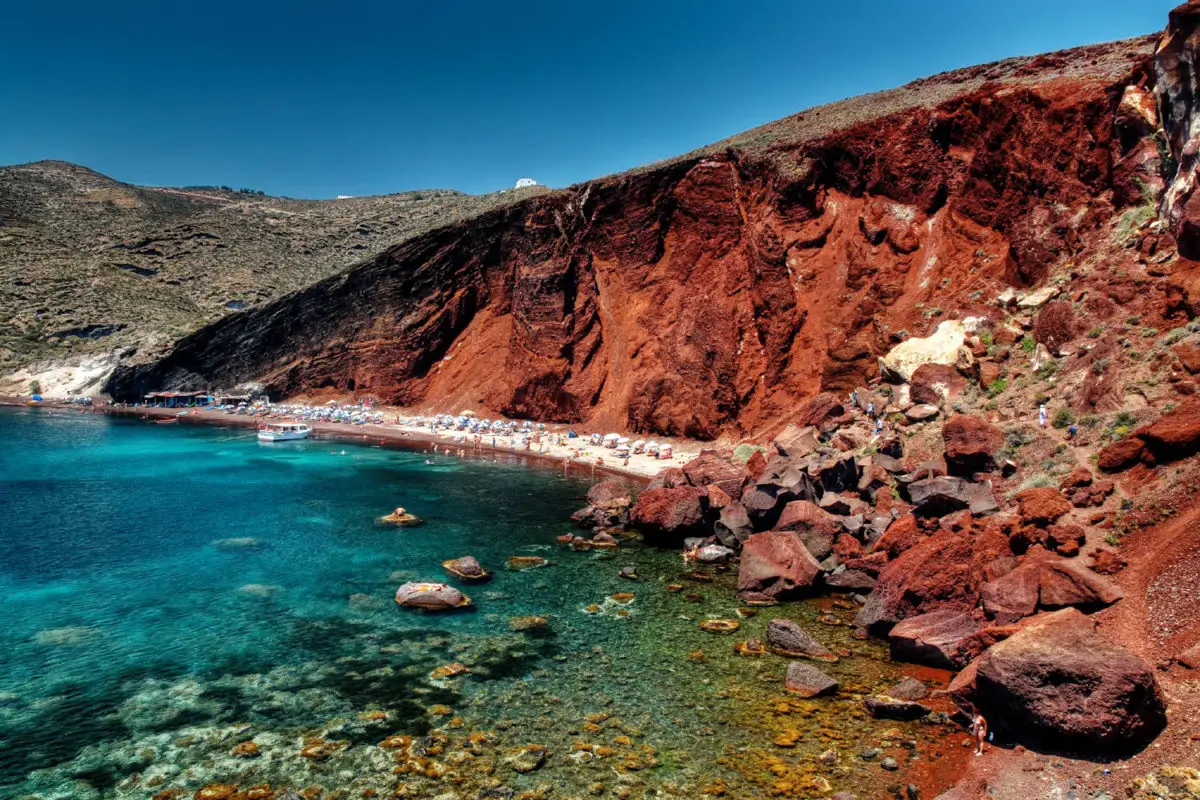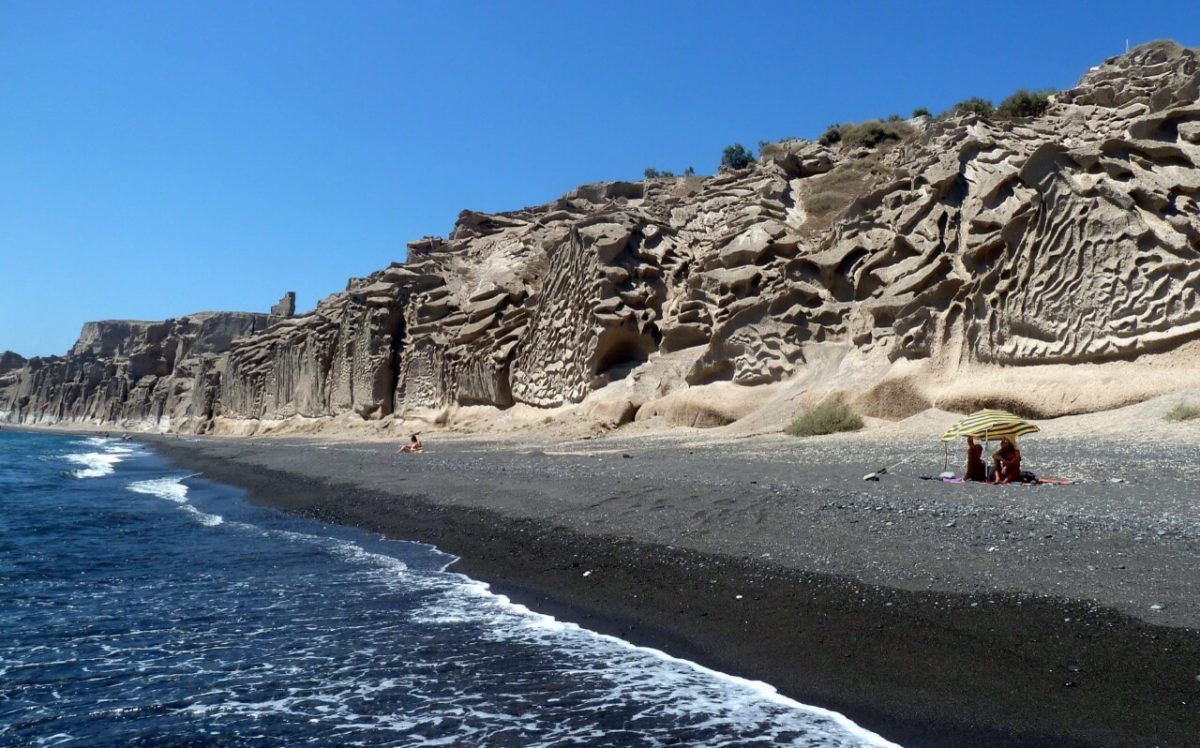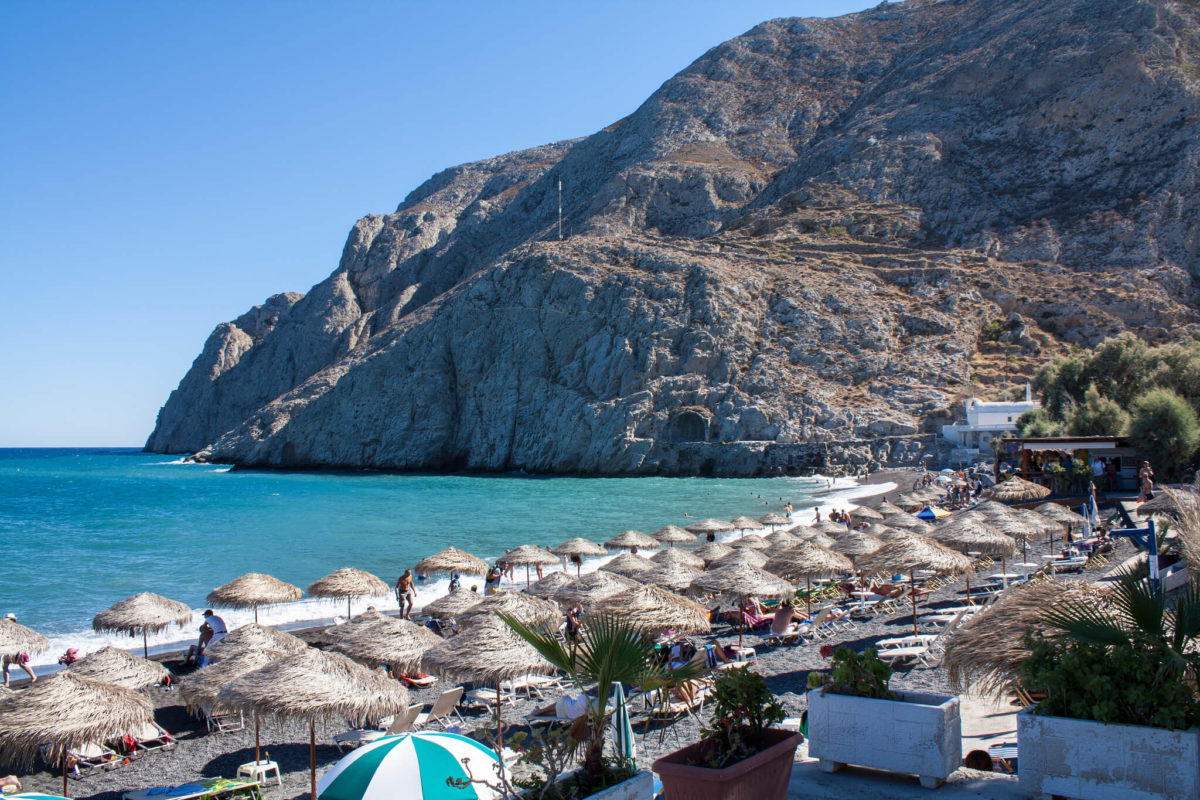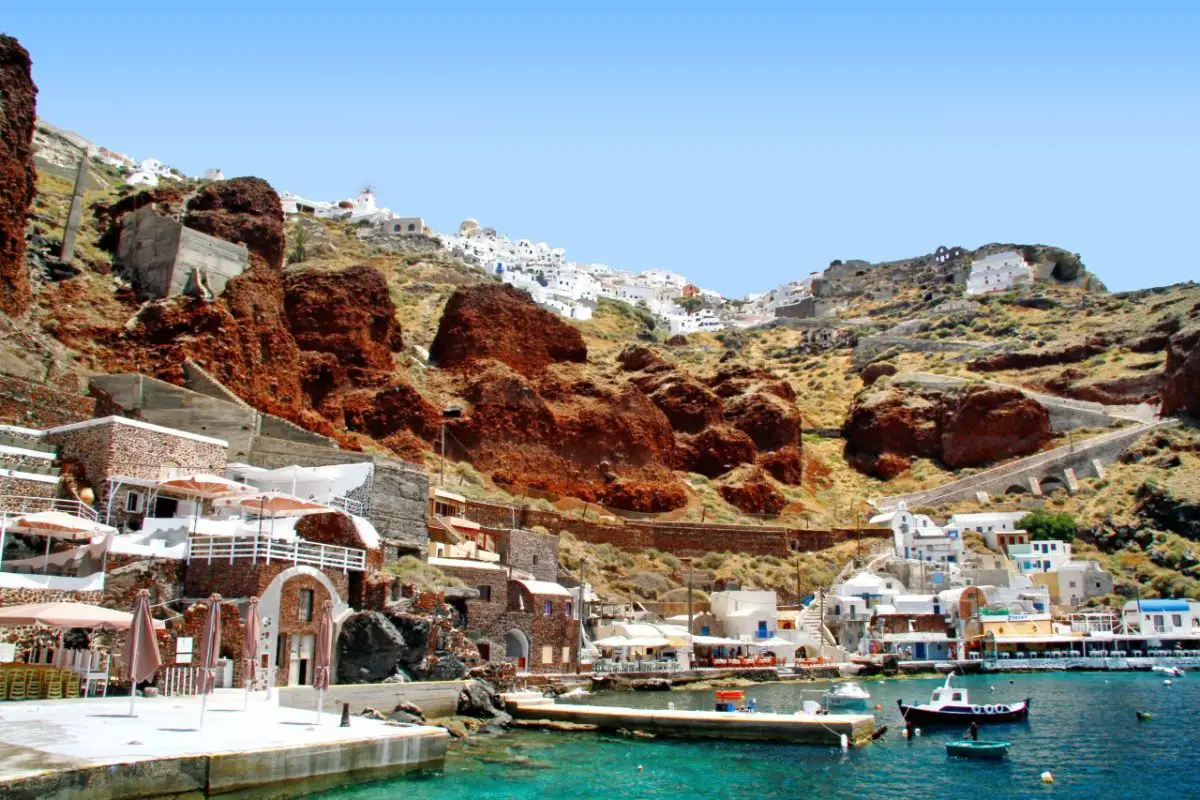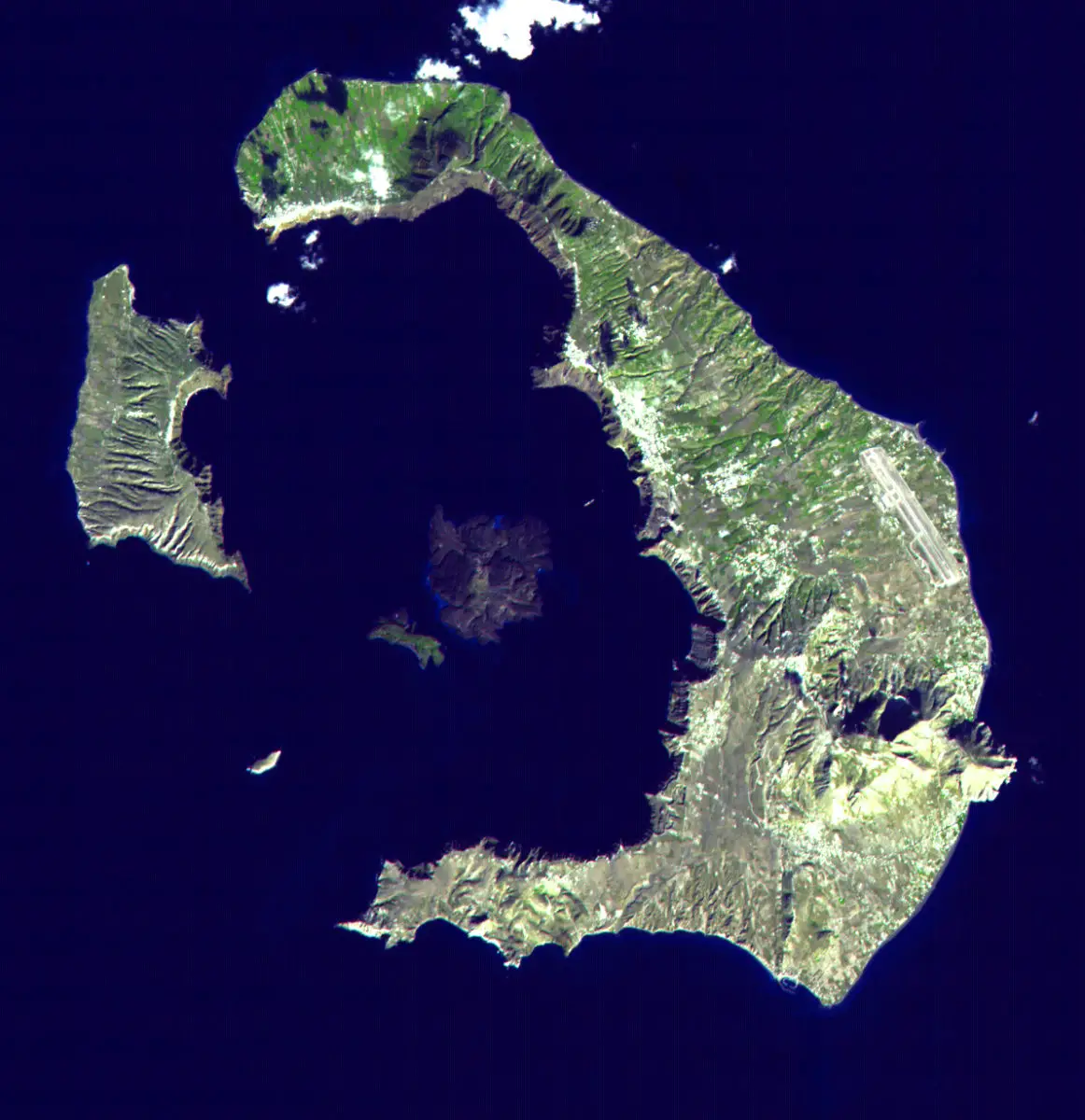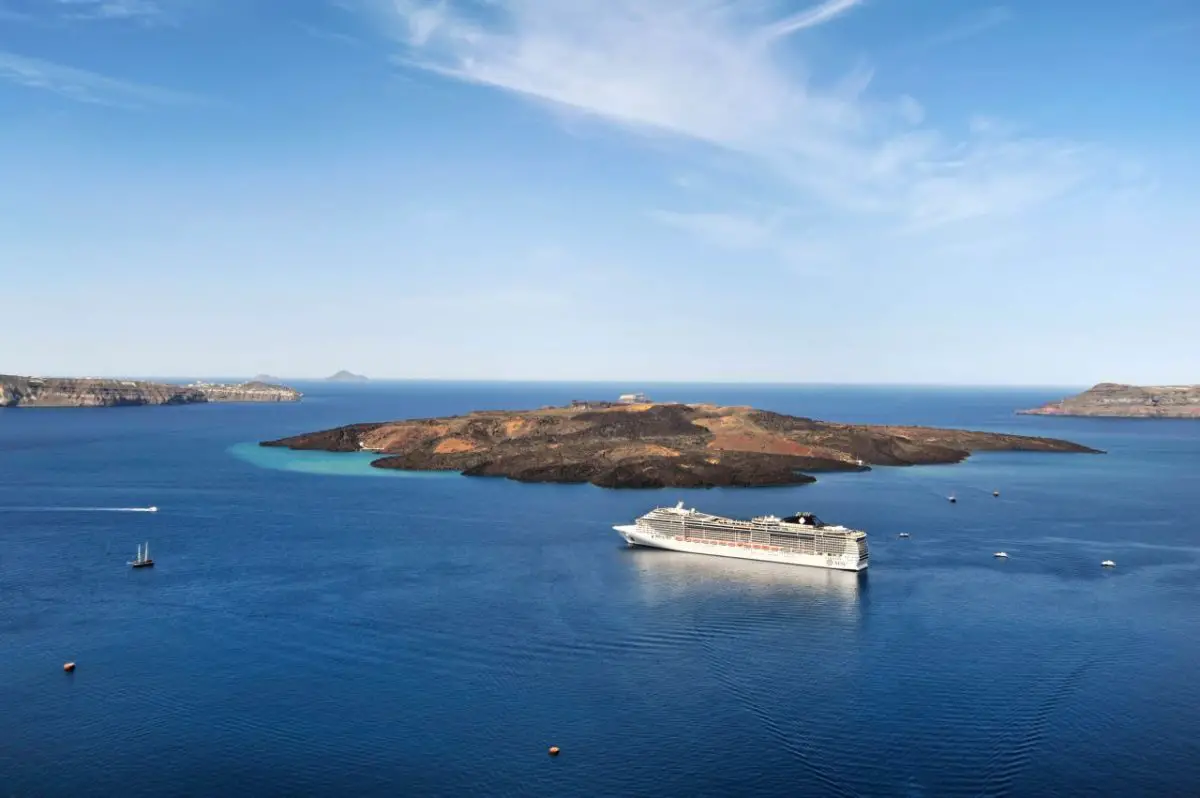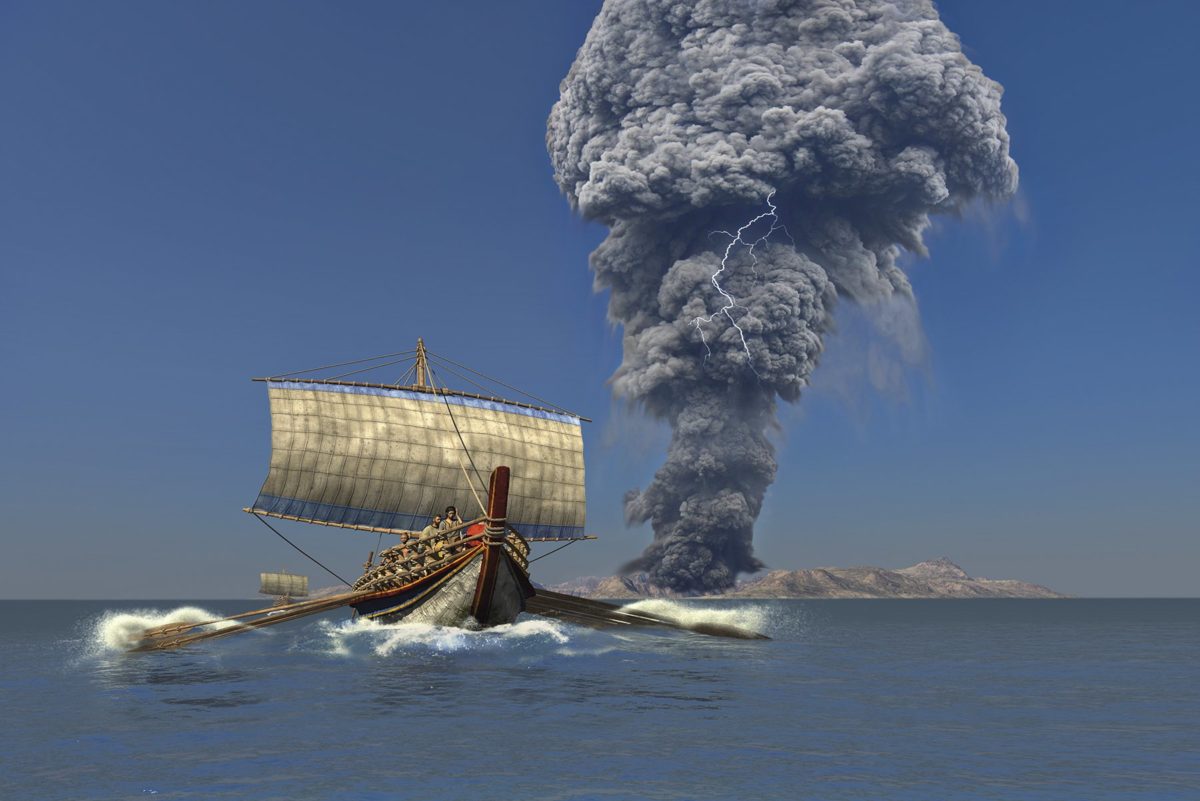The island of Santorini is a Mediterranean village perched on the cliffs overlooking the caldera of the volcano and the Aegean Sea, its landscapes of volcanic formation, its white houses with blue roofs and its crystal clear beaches of black sand with touches of red, is considered the most beautiful and popular island of Greece. For this reason, we invite you to know a little more about the advantages that this extraordinary island has to offer.
Indice De Contenido
Where is the island of Santorini?
The island of Santorini or as it is also known as the island of Thera, is located in the circular archipelago called Cyclades, south of the Aegean Sea which is part of the Mediterranean Sea, its capital is Fira, has a dimension of 73 km2, belongs administratively to Greece, its official language is Greek.
The island of Santorini is located at a distance of approximately 200 kilometres from the mainland of Greece, has an estimated population of 18,000 inhabitants with a population density of 190 inhabitants per square kilometre. The original name of the island was Kallisté, which means the most beautiful island or the most beautiful island, later it was called Théra in honour of Theras, son of Autesión in Greek mythology.
The current name of the island of Santorini is of Italian origin and was generated when the medieval merchants coming from Venice called it Santa Irene, this name is transformed over the years and is transformed into Santo Rini and later Santorini. In 1840, with the actions of unification of the Greek archipelago, the island was given the official name of Théra, but the popular name of Santorini is the one that is most used.
Why visit this island?
The island of Santorini is a place to visit at any time of the year and is one of the Greek islands considered a wonder of nature, for its incredible views from the top of the cliffs, the volcanic relief of the bays and the sunset over the blue sea, but in addition to its wonderful beaches and natural beauty, there are the best jazz festivals in the Mediterranean, the fireworks festival, which simulates a volcanic eruption, and the Santorini Music Festival, where national and international artists perform.
You can also visit the Prehistoric Museum, the Archaeological Museum, the Wine Museum, the Maritime Museum, the ancient churches and monasteries and the ruins of a Venetian castle. You can also take an all-inclusive sea tour by catamaran, which will take you to secret corners to observe the indescribable beauty that the island of Santorini has to offer and to practise sea activities such as snorkelling.
Characteristics of its beaches
The island of Santorini has the most beautiful beaches in the Aegean Sea, its main characteristic is its black sand, as a result of volcanic eruptions, there is something for everyone, family beaches, secluded beaches, beaches with a festive atmosphere, if you are on the island we recommend you visit the following beaches:
Red Beach
Located in the village of Akrotiri, Red Beach is one of the most visited beaches on Santorini, its sand is reddish, black and very hot, so it is a little painful to lie directly on it, but there are chairs and awnings on the beach for protection, Red Beach is ideal for snorkelling as its waters are crystal clear. It is a great experience to visit the red beach, it is considered a must if you go to Santorini island, there you can also taste a sweet visanto made from grapes grown on the island itself.
Many people visit the beach to appreciate the wall of volcanic slabs that lie behind them, a spectacle that can only be seen in a few places on the planet and Red Beach is one of them, many people even never get to step on the sand.
To get to the beach you have to walk for about 10 minutes from the car park, you can also get there by sea using boats called caiques, these are small fishing boats that are used as transport during the season when there are many tourists, they leave from the ports of Akrotiri and Fira.
Vlychada Beach
Vlychada beach is located 13 km from Fira, the capital of the island of Santorini, is characterized by spectacular cliffs that have been sculpted by the different volcanic eruptions, wind and sea, its waters are crystal clear, it is shallow, volcanic and dark sand and has small stones, in this beach you can count with the services of hammocks, umbrellas of natural palm, chairs and a restaurant.
Vlychada beach can be reached by public transport, at the passenger terminal in Fira you can take the bus to the entrance of the beach, just pay attention to the schedule because they leave twice a day to Vlychada beach, in the hotels you can also use the private transport services that almost all the hotels have or rent a car.
In Vlychada beach there is a small port which is the sailing and yachting centre of the place, in the port you can also enjoy the excellent dishes based on fresh fish. The landscape of Vlychada beach is similar to the lunar landscape and this is precisely one of its greatest charms, this beach is classified by its visitors as unique among the different beaches of Santorini island.
Kamari Beach
Kamari is a beach located 9 kilometres southwest of Fira, capital of Santorini, the characteristics of this beach are that its sand is fine and black, the water is crystal clear, has the services of restaurant, chairs, awnings and various services for water sports activities such as snorkelling, kayaking, among others; on the left side of the beach is a large rock called Mesa Vouno, it emerges from the sea, it is a place of incomparable beauty, at night the rock glows in the dark.
Kamari beach can be reached by public transport at the transport terminal of Fira, departures to Kamari are every hour, in the hotels you can also use the private transport services that almost all the hotels have, or by car rental.
Amoudi Bay
Amoudi Bay is located 10 kilometres from Fira, the capital of Santorini, in the lower part of the town of Oia, to reach the bay of the Aegean Sea you have to go down about 250 steps, the place has traditional and modern Mediterranean restaurants where greater importance is given to Greek dishes, as well as the fishing port, to climb back to the village of Oia you can do it walking the 250 steps back or rent the services of a donkey.
The houses at the top of the bay are built on the sides of the stairs, with deep white and blue roofs dug into the volcanic rock, so that going down these stairs you have an extraordinary view of the bay. Amoudi Bay, surrounded by red cliffs, is one of the most representative villages of the island of Santorini, its waters are blue and crystal clear, the place is ideal for diving and swimming, as the beach is rocky we recommend bathing in water shoes.
In the place there is also a small red island that can be reached by swimming is very close to the bay and its waters are very calm, there is a platform on which jumps are made from the cliff of the small island.
To get to Amoudi Bay you can take public transport at the transport terminal in Fira, departures to the village of Oia are hourly, but if you like to walk and have time, from Fira to Oia there are some paths on the way to the cliffs that offer an extraordinary view, do not forget to bring a hat and enough water, in the hotels you can also use the private transport services that almost all the hotels have or through car rental.
Monolithos Beach
Monolithos Beach, located 9 kilometres from the town of Fira, capital of the island of Santorini, is a quiet beach, its name is due to the fact that in the area is located a large rock on which is built the church of Agios Loannis, is a little crowded beach, this beach is recommended for the whole family, It is a long beach with fine grey sand and crystal clear water, it has restaurant services with hammocks, umbrellas and lifeguards, it has a football pitch, basketball and volleyball court, where you can also enjoy the shade provided by the trees near the coast.
The climate
The climate of the island of Santorini in the hot season, which corresponds to the months of June to mid-September, the average temperature is 27 ° C, at this time there are 11 hours of sunshine per day, in the cool season, which comprises the months of December to March, the average temperature is 17 ° C.
The best time to visit Santorini is from early May to mid-October, when there is less chance of rain.
The Flora
The flora of the island of Santorini is poor due to the fact that the surface is covered by a hard layer of ash, but despite these circumstances the island has the following vegetation:
The French or Californian vine or grape.
The Santorini tomato, which is a variety of cherry tomato.
The flowers:
- The burganilla.
- Almond blossom or cherry blossom.
- Japanese cherry blossom.
- The flower of the Llama.
- The Carmelia
The Fauna
The fauna of the island of Santorini is represented by
- Sperm whales.
- Dolphins.
- Mediterranean monk seal.
- Harbour porpoises.
- Cetaceans.
- Crustaceans.
- Molluscs.
Volcanism on the island of Santorini
The place where the island of Santorini is located is a volcanic caldera composed of four superimposed calderas, the oldest caldera is approximately 180,000 years before Christ – BC, the most recent caldera was formed in 1600 BC, the last recorded eruption was in 1950 and currently its volcanic activity is represented by fumaroles in the volcanoes that are active.
The volcanic eruption that occurred in the Minoan era, which is considered to be the first European civilisation of ancient Crete, now Greece, in the seventeenth century BC, on the island of Santorini, was recorded with level 7, this is the highest rating established in the volcanic explosivity index where it measures the strength or magnitude of the volcanic eruption.
In the years 1627 and 1828 BC, the volcanic eruption produced a huge explosion in the caldera of the volcano. C, the volcanic eruption produced a large explosion in the caldera of the volcano, destroyed on the island of Santorini a good part of its land surface, this same volcanic explosion caused a tidal wave, that is when the sea waves accumulate great energy and size moving vertically at high speed, which destroyed the coasts of the eastern Mediterranean Sea, This caused a serious crisis situation in all areas of the Minoan civilisation of Crete, but despite the volcanic activity and the subsequent tsunami the population was able to evacuate to the island, there is a legend that the eruption of Théra, today Santorini, was the one that gave rise to the myth of the lost world of Atlantis mentioned in the texts of the Greek philosopher Plato.
This explosion was so great that the ash and volcanic dust emitted darkened the sky, reaching China 7,000 kilometres away. The magnitude of the volcanic explosion has been recorded in the tree rings of Canada, where there is evidence of the ash and dust from the volcanic explosion on the island of Santorini, Egyptian hieroglyphs have recorded the events of the cloud that covered them. It is estimated that the volcanic phenomenon lasted nine days in north-eastern Africa and the Mediterranean, half a day in China and one hour in Antarctica, which is now southern Chile and Argentina.
The volcano located on the island of Santorini, was chosen by the European Union, a political and legal entity in which one of its objectives is to promote the integration and development of member nations, which are the majority of countries located on the European continent, as the place to carry out studies and volcanic records with a highly specialised human resource and high-tech equipment and tools, taking into account that it is an active volcano and continues to present effusive eruptions – non-explosive.
The following is a list of the eruptions on Santorini:
- 1610 BC (Minoan eruption): volcanic eruption in the central area, explosion with pyroclastic flow where volcanic gases are mixed, hot solid materials generated from the mountain such as stones, rocks and trapped air sliding at ground level at distances ranging from 10 to 200 km/hour, also presented flow of large masses of mud, the collapse of the caldera of the volcano, as well as great damage to the population with many deaths. There is no record of how long the volcanic activity lasted.
- 197 BC: Explosive eruption of the central vent, volcanic fissure, submarine eruption and formation of a new island. There is no record of how long the volcanic activity lasted.
- 31 December 46 to 1 February 47: Eruption through the central vent of the volcano with a large explosion, submarine eruption, magma or lava flow, tsunami or tidal wave.
- 15 July 726: Central fissure eruption, submarine eruption, explosive eruption, lava flow, formation of a new island. There is no record of how long the volcanic activity lasted.
- 1570 to 1573: Eruption of the central vent with volcanic fissure, submarine eruption, explosive eruption, lava flow, formation of a new island.
- 27 September to 6 December 1650: Venting on one side of the volcano, with explosive eruption of fissure, lava flow, volcanic activity produced a tsunami between the two events caused damage to infrastructure and buildings on the island, the presence of deaths and the formation of a new island.
- 26 January 1866 to 15 October 1870: Eruption through the central vent and the volcanic fissure, lava flows, submarine eruption, phreatic eruption, which occurs when the magma of the volcano comes into contact with the surface of the earth containing water and this process causes the water to evaporate rapidly, resulting in an exposure containing water, steam, ash, stones, among other elements. This volcanic activity caused many deaths on the island of Santorini.
- 11th August 1925 to 17th March 1928: Eruption of the central vent causing a volcanic fissure, submarine eruption, phreatic eruption, presence of lava flows.
- 20 August 1939 to 2 July 1941: Central fissure eruption, submarine eruption, phreatic eruption, lava flow.
- 10 January to 2 February 1950: Central ventilation eruption causing a volcanic fissure, submarine eruption, phreatic eruption, lava flow.
History of Santorini
The history of Santorini begins in 1240 AD, when the Venetian Giacomo Barozzi gave the island its present name, as there was a chapel on the island dedicated to Saint Irene, and his descendants remained on the island until 1576.
The island as it is known today was created by the eruption in the Minoan era in the year 1600 BC. The island was at the mercy of the various military powers that dominated the region of the Aegean Sea, so for several centuries the island was part of Egypt, Rome, the Byzantine Empire, the Duchy of Naxos, the Venetian Republic and finally Greece through the negotiations that led to the Treaty of London in 1840.
In 1860, archaeological remains were found in a quarry of pumice, a volcanic stone that floats on water and was used to make concrete in the Suez Canal in the Mediterranean and Red Seas.
Between 1967 and 1970 excavations were carried out on the island of Santorini, it was found that the established society was a rich and culturally prosperous social class, paintings, ceramics and other objects were found very well preserved, which indicate the trade relations they had with Cyprus, Egypt, Asia Minor and all the islands of the Aegean Sea, among the paintings there are three called Boxer Boy, the Fisherman and the Blue Monkeys.
If you enjoyed this article, we invite you to visit the following links:
- Whitsunday Islands
- Saona Island
- Maui Island

